《语言教学的流派》课程教案
《语言教学的流派》课程教案
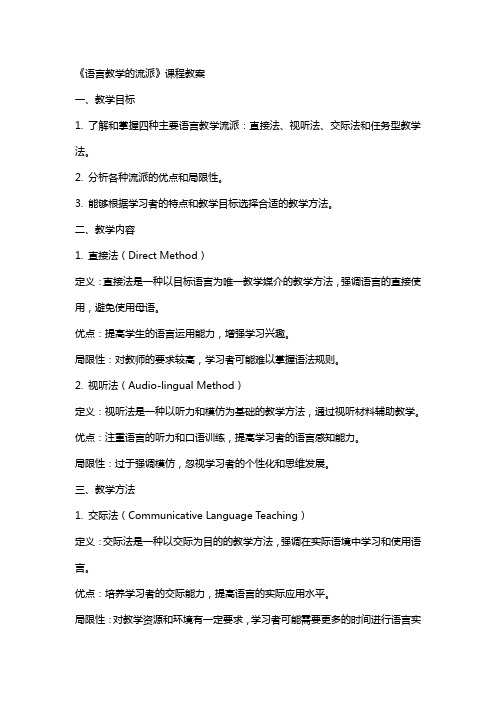
《语言教学的流派》课程教案一、教学目标1. 了解和掌握四种主要语言教学流派:直接法、视听法、交际法和任务型教学法。
2. 分析各种流派的优点和局限性。
3. 能够根据学习者的特点和教学目标选择合适的教学方法。
二、教学内容1. 直接法(Direct Method)定义:直接法是一种以目标语言为唯一教学媒介的教学方法,强调语言的直接使用,避免使用母语。
优点:提高学生的语言运用能力,增强学习兴趣。
局限性:对教师的要求较高,学习者可能难以掌握语法规则。
2. 视听法(Audio-lingual Method)定义:视听法是一种以听力和模仿为基础的教学方法,通过视听材料辅助教学。
优点:注重语言的听力和口语训练,提高学习者的语言感知能力。
局限性:过于强调模仿,忽视学习者的个性化和思维发展。
三、教学方法1. 交际法(Communicative Language Teaching)定义:交际法是一种以交际为目的的教学方法,强调在实际语境中学习和使用语言。
优点:培养学习者的交际能力,提高语言的实际应用水平。
局限性:对教学资源和环境有一定要求,学习者可能需要更多的时间进行语言实践。
2. 任务型教学法(Task-based Language Teaching)定义:任务型教学法是一种以完成实际任务为目标的教学方法,强调学习者的参与和合作。
优点:激发学习者的学习动机,培养解决问题的能力。
局限性:对教师的设计任务能力有一定要求,学习者可能需要更多的时间进行任务完成。
四、教学评估1. 观察学习者的参与程度和语言运用能力。
2. 评估学习者对各种教学方法的理解和运用能力。
3. 收集学习者的反馈意见,以便对教学进行调整和改进。
五、教学资源1. 教材:《语言教学的流派》相关教材或资料。
2. 视听材料:录音机、录像机、多媒体课件等。
3. 网络资源:相关教学网站、论坛、博客等。
教学时间:共计45 分钟。
教学对象:大学英语专业学生或对语言教学感兴趣的学习者。
《语言学流派》课程教学大纲
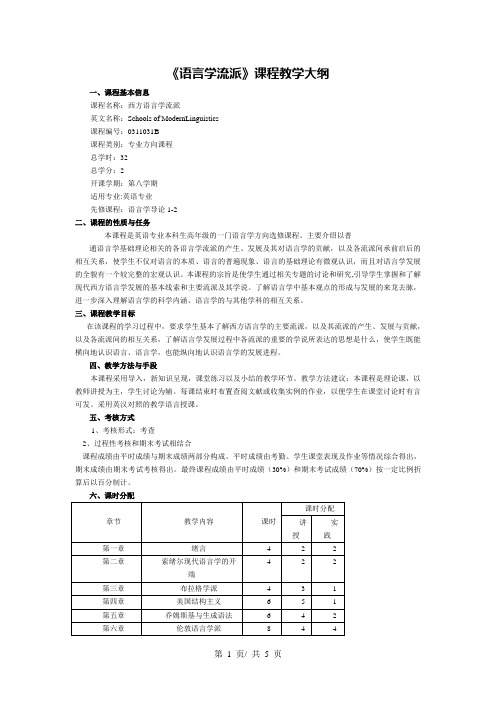
《语言学流派》课程教学大纲一、课程基本信息课程名称:西方语言学流派英文名称:Schools of ModernLinguistics课程编号:0311031B课程类别:专业方向课程总学时:32总学分:2开课学期:第八学期适用专业:英语专业先修课程:语言学导论1-2二、课程的性质与任务本课程是英语专业本科生高年级的一门语言学方向选修课程。
主要介绍以普通语言学基础理论相关的各语言学流派的产生、发展及其对语言学的贡献,以及各流派间承前启后的相互关系,使学生不仅对语言的本质、语言的普遍现象、语言的基础理论有微观认识,而且对语言学发展的全貌有一个较完整的宏观认识。
本课程的宗旨是使学生通过相关专题的讨论和研究,引导学生掌握和了解现代西方语言学发展的基本线索和主要流派及其学说。
了解语言学中基本观点的形成与发展的来龙去脉,进一步深入理解语言学的科学内涵、语言学的与其他学科的相互关系。
三、课程教学目标在该课程的学习过程中,要求学生基本了解西方语言学的主要流派,以及其流派的产生、发展与贡献,以及各流派间的相互关系,了解语言学发展过程中各流派的重要的学说所表达的思想是什么,使学生既能横向地认识语言、语言学,也能纵向地认识语言学的发展进程。
四、教学方法与手段本课程采用导入,新知识呈现,课堂练习以及小结的教学环节。
教学方法建议:本课程是理论课,以教师讲授为主,学生讨论为辅。
每课结束时布置查阅文献或收集实例的作业,以便学生在课堂讨论时有言可发。
采用英汉对照的教学语言授课。
五、考核方式1、考核形式:考查2、过程性考核和期末考试相结合课程成绩由平时成绩与期末成绩两部分构成。
平时成绩由考勤、学生课堂表现及作业等情况综合得出,期末成绩由期末考试考核得出。
最终课程成绩由平时成绩(30%)和期末考试成绩(70%)按一定比例折算后以百分制计。
六、课时分配七、教学内容安排第一章绪言(4学时)【教学目标】1.了解西方语言学的主要流派2.理解什么是语言以及语言的区别性特征3.掌握语言学的主要分支【教学内容】1.语言的定义2.语言的特征3.语言的起源4.语言的功能5.语言学的内涵6.语言学的主要分支7.西方语言学主要流派【教学重点】1.什么是语言,语言的特征和功能2.什么是语言学,语言学的研究范围及分支【教学难点】西方主要语言学流派【学时数】1.课堂讲述3学时2.课堂讨论、习题讲解1学时第二章索绪尔现代语言学的开端(4学时)【教学目标】1.了解语言学的历史发展2.理解索绪尔语言学理论产生的背景及对现代语言学的发展的贡献及影响3.掌握索绪尔的主要语言学观点【教学内容】1.语言学的历史发展2.索绪尔语言学生产的背景3.索绪尔的主要语言学观点4.索绪尔的影响【教学重点】1.索绪尔语言学生产的背景2.语言的任意性3.共时语言学和历时语言学4. 索绪尔的影响【教学难点】1.语言和言语2.聚合关系和组合关系【学时数】1.课堂讲述3学时2.课堂讨论、习题讲解1学时第三章布拉格学派(4学时)【教学目标】1.了解布拉格学派背景2.理解拉格学派主要内容和贡献3.掌握音位学中的主要概念以及主位结构【教学内容】1.布拉格学派背景2.音位学3.句子功能展示成分【教学重点】1.功能语言观2.音位学【教学难点】1.主位和述位2.交际动力【学时数】1.课堂讲述3学时2.课堂讨论、习题讲解1学时第四章美国结构主义(6学时)【教学目标】1.了解语言学在美国的发展的主要特点2.理解解美国结构主义主要内容及代表语言学家3.掌握萨皮尔沃尔夫假设的主要内容以及行为主义语言观的内容【教学内容】1.美国结构主义的主要特点2早期代表语言学家博厄斯和萨丕尔3.萨丕尔—沃尔夫假说4.布龙菲尔德和行为主义【教学重点】1.美国结构主义的主要特点2.主要代表语言学家的观点理论【教学难点】1.萨丕尔—沃尔夫假说2.布龙菲尔德和行为主义【学时数】1.课堂讲述5学时2.课堂讨论、习题讲解1学时第五章乔姆斯基与生成语法(6学时)【教学目标】1.了解乔姆斯基的转换生成语法的背景2.理解转换生成语法的三个发展阶段3.掌握天赋假设的主要内容【教学内容】1.天赋假设2.什么是生成语法3.经典理论4.标准理论5.扩展的标准理论6.管约理论【教学重点】1.乔姆斯基的语言观2.标准理论时期【教学难点】天赋假设【学时数】1.课堂讲述5学时2.课堂讨论、习题讲解1学时第六章伦敦语言学派(8学时)【教学目标】1.了解伦敦语言学派的背景2.理解伦敦语言学派的主要语言学家及其理论观点3.掌握韩礼德的语言三大元功能理论【教学内容】1. 马林诺夫斯基的语言理论2. 佛斯的语言理论3. 韩礼德与系统功能语法【教学重点】1.佛斯的语言理论2.韩礼德的语言三大元功能理论【教学难点】1.语言的概念功能2.及物性【学时数】1.课堂讲述7学时2.课堂讨论、习题讲解1学时八、教材及主要参考书1.教材:刘润清.西方语言学流派[M]. 北京:外语教学与研究出版社,2002.2.主要参考书:1) BrownG.& Yule G.(2000) Discourse Analysis. Beijing: Foreign Language Teachingand Research Press.2) RadfordA.(2000) Transformational Grammar: A First Course. Beijing: ForeignLanguage Teaching and Research Press.3) 封宗信.现代语言学流派概论[M].北京:北京大学出版社. 20064) 胡明扬.西方语言学名著选读[M].北京:中国人民大学出版社.20075)胡壮麟.语言学教程(第四版)[M].北京:北京大学出版社.2007.6)胡壮麟.叶起昌.语言学理论与流派[M].北京:高等教育出版社.20107)黄衍.试论英语主位和述位.[J].上海外国语大学学报.19858)刘润清,封宗信.语言学理论与流派[M].南京:南京师范大学出版社。
《语言教学的流派》课程教案

《语言教学的流派》课程教案一、课程概述1. 课程名称:语言教学的流派2. 课程目标:使学生了解和掌握各种语言教学流派的基本概念、特点和优缺点,提高学生对语言教学的认识和理解。
3. 课程内容:本课程共十个章节,分别为认知法、交际法、任务型教学法、直接法、听说法、全身反应法、情境教学法、语法翻译法、自然法和沉默法。
二、教学对象1. 学生对象:本课程适用于英语教育专业的本科生和研究生,以及对语言教学感兴趣的其他专业学生。
2. 学生水平:学生应具备基本的英语语言知识和一定的语言教学实践经验。
三、教学方法1. 讲授法:教师通过讲解、举例等方式,向学生传授各种语言教学流派的基本概念、特点和优缺点。
2. 案例分析法:教师提供实际的语言教学案例,引导学生分析、讨论和评价各种流派的适用性和效果。
3. 小组讨论法:学生分组讨论,分享对不同语言教学流派的看法和经验,促进学生之间的交流和互动。
四、教学内容第一章:认知法1. 认知法的基本概念和理论基础2. 认知法的教学原则和步骤3. 认知法的优缺点及适用范围第二章:交际法1. 交际法的基本概念和理论基础2. 交际法的教学原则和步骤3. 交际法的优缺点及适用范围第三章:任务型教学法1. 任务型教学法的基本概念和理论基础2. 任务型教学法的教学原则和步骤3. 任务型教学法的优缺点及适用范围第四章:直接法1. 直接法的基本概念和理论基础2. 直接法的教学原则和步骤3. 直接法的优缺点及适用范围第五章:听说法1. 听说法的基本概念和理论基础2. 听说法的教学原则和步骤3. 听说法的优缺点及适用范围五、教学评估1. 课堂参与度:评估学生在课堂上的发言和互动情况,考察学生的积极性和合作精神。
2. 小组讨论报告:评估学生在小组讨论中的表现和成果,考察学生的分析能力和团队合作能力。
六、全身反应法1. 全身反应法的基本概念和理论基础2. 全身反应法的教学原则和步骤3. 全身反应法的优缺点及适用范围七、情境教学法1. 情境教学法的基本概念和理论基础2. 情境教学法的教学原则和步骤3. 情境教学法的优缺点及适用范围八、语法翻译法1. 语法翻译法的基本概念和理论基础2. 语法翻译法的教学原则和步骤3. 语法翻译法的优缺点及适用范围九、自然法1. 自然法的基本概念和理论基础2. 自然法的教学原则和步骤3. 自然法的优缺点及适用范围十、沉默法1. 沉默法的基本概念和理论基础2. 沉默法的教学原则和步骤3. 沉默法的优缺点及适用范围2. 探讨语言教学流派的未来发展及其对我国英语教育的影响3. 强调学生在实际教学中的应用能力和创新精神十二、教学资源与参考文献1. 推荐相关教材、论文和著作2. 提供网络资源和实践案例,以供学生进一步学习和参考重点和难点解析一、课程概述难点解析:如何合理安排课程内容,使之既有深度又有广度,达到课程目标。
语言教学的流派课程教案
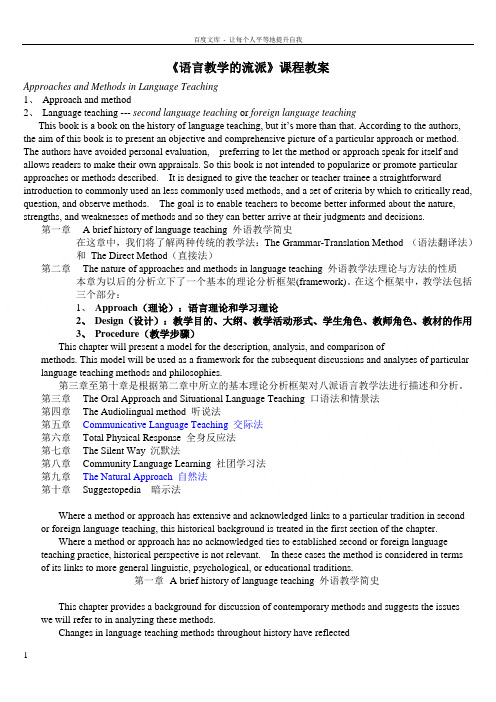
《语言教学的流派》课程教案Approaches and Methods in Language Teaching1、Approach and method2、Language teaching --- second language teaching or foreign language teachingThis book is a book on the history of language teaching, but it’s more than that. According t o the authors, the aim of this book is to present an objective and comprehensive picture of a particular approach or method. The authors have avoided personal evaluation, preferring to let the method or approach speak for itself and allows readers to make their own appraisals. So this book is not intended to popularize or promote particular approaches or methods described. It is designed to give the teacher or teacher trainee a straightforward introduction to commonly used an less commonly used methods, and a set of criteria by which to critically read, question, and observe methods. The goal is to enable teachers to become better informed about the nature, strengths, and weaknesses of methods and so they can better arrive at their judgments and decisions.第一章 A brief history of language teaching 外语教学简史在这章中,我们将了解两种传统的教学法:The Grammar-Translation Method (语法翻译法)和The Direct Method(直接法)第二章The nature of approaches and methods in language teaching 外语教学法理论与方法的性质本章为以后的分析立下了一个基本的理论分析框架(framework)。
语言学理论与流派教案大纲

语言学理论与流派教案大纲第一章:引言1.1 语言学的定义与重要性1.2 语言学的发展历程1.3 语言学的研究方法与学科分支1.4 语言学与相关学科的关系1.5 教案大纲的安排与学习目标第二章:结构主义语言学2.1 结构主义语言学的背景与发展2.2 Ferdinand de Saussure 的语言学理论2.3 Charles F. Hockett 与结构主义语言学的发展2.4 结构主义语言学的主要观点与贡献2.5 结构主义语言学的局限性与批评第三章:功能主义语言学3.1 功能主义语言学的背景与发展3.2 Roman Jakobson 的语言功能理论3.3 Michael Halliday 的系统功能语法3.4 功能主义语言学的主要观点与贡献3.5 功能主义语言学的局限性与批评第四章:转换语言学4.1 转换语言学的背景与发展4.2 Noam Chomsky 的Generative Grammar 理论4.3 转换语言学的主要观点与贡献4.4 转换语言学的局限性与批评4.5 转换语言学在语言教学中的应用第五章:认知语言学5.1 认知语言学的背景与发展5.2 George Lakoff 的认知语义理论5.3 Ronald Langacker 的认知语言学理论5.4 认知语言学的主要观点与贡献5.5 认知语言学的局限性与批评第六章:社会语言学6.1 社会语言学的定义与发展6.2 社会语言学的重要理论家与贡献6.3 语言与社会的相互影响6.4 语言变体与方言6.5 社会语言学在语言教学中的应用第七章:语用学7.1 语用学的定义与发展7.2 语用学的重要理论家与贡献7.3 语用学的基本概念与理论7.4 语言的理解与使用7.5 语用学在语言教学中的应用第八章:历史语言学8.1 历史语言学的定义与发展8.2 历史语言学的重要理论家与贡献8.3 语言变化与语言演变8.4 语言关系与语言谱系8.5 历史语言学在语言教学中的应用第九章:比较语言学9.1 比较语言学的定义与发展9.2 比较语言学的重要理论家与贡献9.3 语言的比较方法与原则9.4 语言结构的共性与差异9.5 比较语言学在语言教学中的应用第十章:话语分析10.1 话语分析的定义与发展10.2 话语分析的重要理论家与贡献10.3 话语的结构与类型10.4 话语的理解与解释10.5 话语分析在语言教学中的应用第十一章:心理语言学11.1 心理语言学的定义与发展11.2 心理语言学的重要理论家与贡献11.3 语言的认知过程11.4 语言习得与学习理论11.5 心理语言学在语言教学中的应用第十二章:神经语言学12.1 神经语言学的定义与发展12.2 神经语言学的重要理论家与贡献12.3 语言与大脑的关系12.4 失语症与语言障碍12.5 神经语言学在语言教学中的应用第十三章:应用语言学13.1 应用语言学的定义与发展13.2 应用语言学的重要理论家与贡献13.3 语言教学方法与策略13.4 语言测试与评估13.5 应用语言学在语言教学中的应用第十四章:全球化与语言14.1 全球化的定义与对语言的影响14.2 语言全球化的现象与特点14.3 世界语言的分布与变化14.4 语言多样性的保护与维护14.5 全球化背景下的语言教学策略第十五章:未来语言学的趋势与挑战15.1 科技发展对语言学的影响15.2 与自然语言处理15.3 语言学的跨学科研究15.4 语言学教育的创新与改革15.5 语言学家面临的未来挑战与机遇重点和难点解析第一章:引言重点:语言学的定义、发展历程、研究方法与学科分支。
语言教学流派

一、语法翻译法(Grammar--Translation Method)盛行于18世界末,代表人物奥伦多夫。
主要特点:①教授语法学家确定的所谓“规范”的语言,所使用的语言材料多以古老和过时的例句为主。
②注重书面语,不重口语。
③语法的讲解不仅注重规则的东西,而且十分注重不规则的东西。
、④课堂教学使用本族语⑤教学方法以翻译为主,通过大量笔头翻译和写作练习来检验语法规则的掌握情况。
教学过程:先教字母发音和书写,然后系统地教语法,最后阅读原文。
语法课顺序:○1先讲词法后讲语法。
○2用演绎法讲授语法规则。
○3用本族语和外语互译方法巩固所学语法规则。
理论基础:说法不一○1没什么理论基础。
○2机械语言学和联想心理学○3传统语言学(重视确定语言规范,定出各种语言规则)○4官能心理学○5唯理主义哲学优点:1.利用本族语,把翻译作为讲解与巩固外语的手段。
2.主张讲授语法知识,发展学生的智力3.注重阅读,注重学习原文,特别是文学名著。
4.使用方便,不需要专门训练,对口语要求不高,不需要发杂设备和教具,教学进程易于检查和控制。
缺点:1.忽视口语2.过分依赖母语3.过分强调语法。
二、直接法(Direct Method)别名【改革法、自然法、心理法、口语法、妥协法、综合直接法、折衷直接法、循序渐进直接法】产生于19世纪后,代表人物:贝力兹、艾盖尔特和帕默教学原则和特点:主要原则1.直接联系的原则:建立语言与外界经验的直接联系2.以口语为基础的原则:口语教学是入口阶段的主要手段和目的3.句本位原则:从句子入手,以句子为单位,整句进整句出。
4.以模仿为主的原则:通过模仿手段重复所学句子,养成习惯,达到自动化的地步。
此外还有精选语言材料的原则,循序渐进原则原则,趣味性。
教学过程:口语教学:不翻译而演示;不解释而动作;不演说而问问题;不模仿学生错误而纠正;不单说词而说句子;教师少说让学生多说;不使用教科书而使用教学计划;不要离题而要按计划进行;不要进度太快,而要保持学生的适当进度;不要说得太慢而要用正常语速;不要说得太快,而要说得自然;不要用大嗓门儿,而要说得自然;不要急躁,而要放松。
语言学理论与流派教案大纲
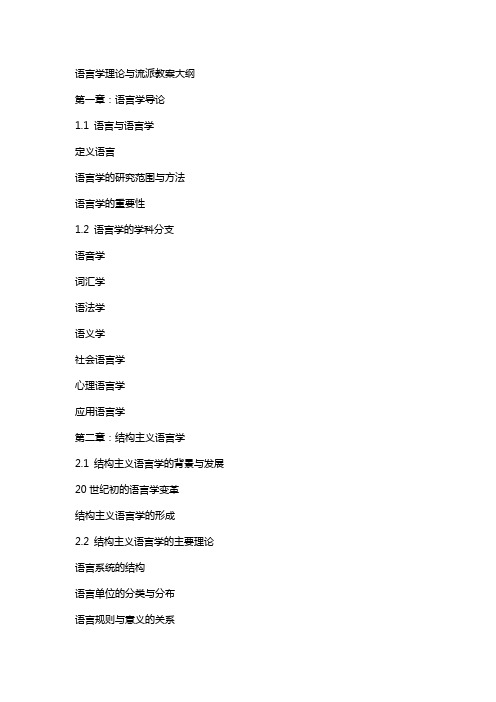
语言学理论与流派教案大纲第一章:语言学导论1.1 语言与语言学定义语言语言学的研究范围与方法语言学的重要性1.2 语言学的学科分支语音学词汇学语法学语义学社会语言学心理语言学应用语言学第二章:结构主义语言学2.1 结构主义语言学的背景与发展20世纪初的语言学变革结构主义语言学的形成2.2 结构主义语言学的主要理论语言系统的结构语言单位的分类与分布语言规则与意义的关系2.3 结构主义语言学的影响与应用对语言教学的影响在语言研究中的应用第三章:功能主义语言学3.1 功能主义语言学的背景与发展反对结构主义语言学的局限性功能主义语言学的形成3.2 功能主义语言学的主要理论语言的功能与功能系统语言的社会意义与语境语言的交际能力与交际过程3.3 功能主义语言学的影响与应用对语言教学的影响在语言研究中的应用第四章:转换语言学4.1 转换语言学的背景与发展乔姆斯基的语言习得装置理论转换语言学的形成4.2 转换语言学的主要理论语言的深层与表层结构转换规则与短语结构规则语言的普遍语法与参数理论4.3 转换语言学的影响与应用对语言教学的影响在语言研究中的应用第五章:认知语言学5.1 认知语言学的背景与发展认知科学的兴起认知语言学的形成5.2 认知语言学的主要理论语言的认知模型与概念结构隐喻与转喻理论语言的范畴化与原型理论5.3 认知语言学的影响与应用对语言教学的影响在语言研究中的应用第六章:语用学理论6.1 语用学的定义与研究对象语用学的概念语用学的研究范围语用学的重要性6.2 语用学的主要理论意义与语境的关系语言的交际功能与语用原则言语行为理论6.3 语用学在语言教学与研究中的应用对语言教学的影响在语言研究中的应用第七章:社会语言学理论7.1 社会语言学的背景与发展语言与社会的关系社会语言学的形成7.2 社会语言学的主要理论语言变体与语言变异语言与社会身份的关系语言态度与语言意识形态7.3 社会语言学在语言教学与研究中的应用对语言教学的影响在语言研究中的应用第八章:心理语言学理论8.1 心理语言学的背景与发展语言与大脑的关系心理语言学的形成8.2 心理语言学的主要理论语言的加工过程与认知机制语言习得与学习理论语言障碍与康复8.3 心理语言学在语言教学与研究中的应用对语言教学的影响在语言研究中的应用第九章:应用语言学理论9.1 应用语言学的定义与研究范围应用语言学的概念应用语言学的研究领域应用语言学的重要性9.2 应用语言学的主要理论语言教学法与发展第二语言习得理论语言测试与评估9.3 应用语言学在语言教学与研究中的应用对语言教学的影响在语言研究中的应用第十章:语言学理论与流派的综合与应用10.1 语言学理论的综合不同理论之间的关系与融合跨学科研究与综合视角10.2 语言学理论在实践中的应用语言教学案例分析语言研究项目示例10.3 语言学理论的未来发展趋势新技术与语言学理论的结合跨文化交际与语言学理论的发展重点和难点解析重点一:语言学导论中的语言与语言学概念语言的定义:语言是一种符号系统,用于表达和交流思想、情感和意愿。
语言学理论与流派教案大纲
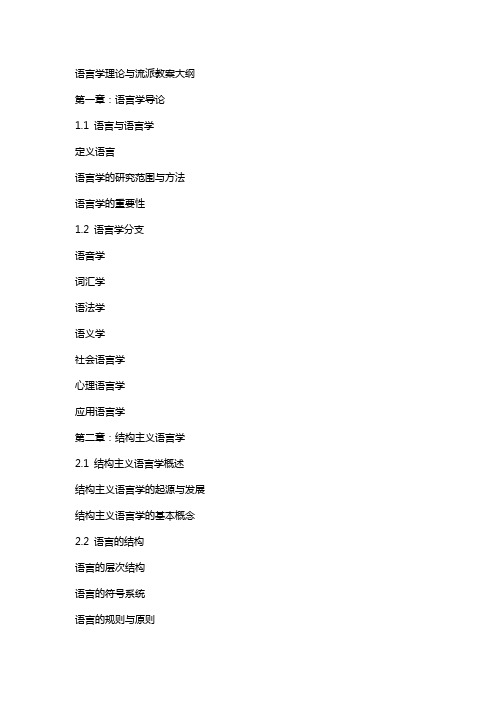
语言学理论与流派教案大纲第一章:语言学导论1.1 语言与语言学定义语言语言学的研究范围与方法语言学的重要性1.2 语言学分支语音学词汇学语法学语义学社会语言学心理语言学应用语言学第二章:结构主义语言学2.1 结构主义语言学概述结构主义语言学的起源与发展结构主义语言学的基本概念2.2 语言的结构语言的层次结构语言的符号系统语言的规则与原则2.3 结构主义语言学代表人物费尔迪南·德·索绪尔鲁思·哈里森克劳德·列维-斯特劳斯第三章:功能主义语言学3.1 功能主义语言学概述功能主义语言学的起源与发展功能主义语言学的基本概念3.2 语言的功能交际功能表达功能认知功能3.3 功能主义语言学代表人物罗杰·费尔盾迈克尔·阿诺德约翰·菲尔莫尔第四章:转换语言学4.1 转换语言学概述转换语言学的起源与发展转换语言学的基本概念4.2 语言的能力短语结构规则转换规则词汇规则4.3 转换语言学代表人物诺姆·乔姆斯基约翰·霍奇金森马克·拉宾纳第五章:认知语言学5.1 认知语言学概述认知语言学的起源与发展认知语言学的基本概念5.2 认知语言学的理论基础认知心理学语言习得理论概念结构理论5.3 认知语言学代表人物乔治·莱考夫约翰·泰勒尤里·施密特第六章:语用学与交际语言学6.1 语用学概述语用学的定义与研究范围语用学的重要性与实际应用6.2 交际语言学的基本理论交际语言学的起源与发展语言交际的过程与要素6.3 语用学与交际语言学的代表人物约翰·范德·沃尔赫伯特·帕克塞尔玛·舍尔第七章:社会语言学7.1 社会语言学概述社会语言学的起源与发展社会语言学的基本概念7.2 社会语言学的主要理论言语社区理论语言态度与身份认同语言变异与变化7.3 社会语言学的代表人物丹尼尔·朱克拉里·阿尔德海德珍妮特·费尔第八章:心理语言学8.1 心理语言学概述心理语言学的起源与发展心理语言学的基本概念8.2 语言的认知过程语言的理解与产生语言的习得与遗忘语言与思维的关系8.3 心理语言学的代表人物乔治·米勒认知心理学与语言斯蒂芬·平克第九章:应用语言学9.1 应用语言学概述应用语言学的定义与研究范围应用语言学的重要性与实际应用9.2 语言教学理论与方法直接法视听法交际法9.3 应用语言学的代表人物约瑟夫·奥尔曼斯蒂芬·克拉森罗杰·天使第十章:语言学发展趋势与展望10.1 语言学的发展趋势跨学科研究语言学与技术的结合全球化背景下的语言学10.2 语言学的重要性与挑战语言学在现代社会的作用语言学面临的挑战与应对策略10.3 语言学未来的发展方向探索人类语言能力语言学与其他领域的融合促进语言学的普及与教育重点和难点解析重点环节一:语言与语言学语言的定义:语言是人类交流与思维的重要工具,是一种系统化的符号活动。
- 1、下载文档前请自行甄别文档内容的完整性,平台不提供额外的编辑、内容补充、找答案等附加服务。
- 2、"仅部分预览"的文档,不可在线预览部分如存在完整性等问题,可反馈申请退款(可完整预览的文档不适用该条件!)。
- 3、如文档侵犯您的权益,请联系客服反馈,我们会尽快为您处理(人工客服工作时间:9:00-18:30)。
《语言教学的流派》课程教案课程介绍:对外汉语教学是一门新兴的学科,属于应用语言学,狭义的应用语言学指的就是语言教学,因此对外汉语教学要从外语教学的研究中吸取营养。
国外的外语教学研究较早,成果丰富,我们一定要去借鉴,才可能根据汉语特点来推动对外汉语教学法的研究。
这门课程是对外汉语专业本科生的专业选修课,其目的在于让学生直接阅读外文资料,并在学习的过程中学习理论分析的方法,提高理论和学术素养。
要求:1、熟悉每章的key words2、Make presentation in English3、积极参加课堂讨论4、认真预习和完成课后作业5、期末考查方式:passage translation(英译汉)教材介绍:20世纪外语教学蓬勃发展,教学法的研究也发展很快。
一方面,19世纪一些传统的教学法传承下来;另一方面,20世纪有许多创新的教学法。
Jack C. Richard 和Theodore S. Rodgers 所著的Approaches and Methods in Language Teaching 一书对20世纪出现的几个具有代表性的教学法进行描述和分析,有助于我们了解历史,承前启后。
Approaches and Methods in Language Teaching1、Approach and method2、Language teaching --- second language teaching or foreign language teachingThis book is a book on the history of language teaching, but it’s more than that. Accordin g to the authors, the aim of this book is to present an objective and comprehensive picture of a particular approach or method. The authors have avoided personal evaluation, preferring to let the method or approach speak for itself and allows readers to make their own appraisals. So this book is not intended to popularize or promote particular approaches or methods described. It is designed to give the teacher or teacher trainee a straightforward introduction to commonly used an less commonly used methods, and a set of criteria by which to critically read, question, and observe methods. The goal is to enable teachers to become better informed about the nature, strengths, and weaknesses of methods and so they can better arrive at their judgments and decisions.第一章 A brief history of language teaching 外语教学简史本章主要介绍20世纪以前的外语教学简史通过此章的学习,我们将会发现20世纪出现的教学法都是历史的延续和发展。
在这章中,我们将了解两种传统的教学法:The Grammar-Translation Method(语法翻译法)和The Direct Method(直接法)第二章The nature of approaches and methods in language teaching 外语教学法理论与方法的性质本章为以后的分析立下了一个基本的理论分析框架(framework)。
在这个框架中,教学法包括三个部分:1、Approach(理论):语言理论和学习理论2、Design(设计):教学目的、大纲、教学活动形式、学生角色、教师角色、教材的作用3、Procedure(教学步骤)This chapter will present a model for the description, analysis, and comparison of methods. This model will be used as a framework for the subsequent discussions and analyses of particular language teaching methods and philosophies.第三章至第十章是根据第二章中所立的基本理论分析框架对八派语言教学法进行描述和分析。
第三章The Oral Approach and Situational Language Teaching 口语法和情景法第四章The Audiolingual method 听说法第五章Communicative Language Teaching 交际法第六章Total Physical Response 全身反应法第七章The Silent Way 沉默法第八章Community Language Learning 社团学习法第九章The Natural Approach 自然法第十章Suggestopedia 暗示法Where a method or approach has extensive and acknowledged links to a particular tradition in second or foreign language teaching, this historical background is treated in the first section of the chapter.Where a method or approach has no acknowledged ties to established second or foreign language teaching practice, historical perspective is not relevant. In these cases the method is considered in terms of its links to more general linguistic, psychological, or educational traditions.第十一章教学法的比较和评估这章是从更高的一个角度对前几章所分析的教学法进行比较和评估。
This chapter examines methods from a broader framework and present a curriculum-development perspective on methodology.第一章 A brief history of language teaching 外语教学简史This chapter provides a background for discussion of contemporary methods and suggests the issues we will refer to in analyzing these methods.Changes in language teaching methods throughout history have reflecteda.Recognition of changes in the kind of proficiency learners need (oralproficiency or reading comprehension)b.Changes in theories of the nature of language and of language learning.一、500年前:1、拉丁语的地位2、拉丁语的教学法3、the decline of Latin4、受拉丁语教学法影响的modern language(如英语、德语、法语等等)的教学法这种方法就是The Grammar-Translation Method二、The Grammar-Translation Method1、对这种方法的评价2、这种教学法的主要特点:7点the goal of foreign language learningreading and writing/speaking and listeningvocabulary selectionsentenceaccuracygrammarthe student’s native language3、对这种教学法的批评三、Language teaching innovations in the 19th century1、Increased opportunities for communication: oral proficiency2、Individual language teaching specialists:C. Marcel: emphasized the important meaning in learningT. Prendergast: proposed the first “structural syllabus”F.Gouin: “series”四、The Reform Movement1、语言学的发展:The International Phonetic Association(1886年)2、Reformer 的观点Henry Sweet: The Practical Study of Languages(1899年)Wilhelm Vietor: Language Teaching Must Start Afresh共同的观点:6点the spoken languagephoneticshear the language firstwords and sentencesthe rules of grammartranslation3、natural methods 的兴起,其中一种就是众所周知的Direct Method五、The Direct Method1、倡导者:Gouin ;Sauveurfoundation: natural language learning principles2、Berlitz Method :principles and proceduresguidelines3、drawbacks六、The Coleman Report:1929 in the United States七、method 到底是什么?the goals of language teachingthe basic nature of languagethe selection of language contentprinciples of organization, sequencing and presentationthe role of the native languageprocessbest teaching techniques and activities and circumstancesParticular methods differ in the way they address these issues. We need to present a model for the description, analysis, and comparison of methods.Question for discussion:从语法翻译法到直接法,有了哪一些进步?500 years ago, Latin was the dominant language of education, commerce, religion, and government in the Western world. But Latin was not a language of spoken and written communication. It was a dead language. Children enter grammar school to learn Latin in order to read classical works of famous Latin writers such as Virgil, Ovid, and Cicero and to develop intellectual abilities. Latin was taught through rote learning of grammar rules, translation and practice in writing sample sentences.In eighteenth century, “modern” languages such as English, French and Italian began to enter European schools, and they were taught using the same way that were used for teaching Latin. Textbooks consisted of abstract grammar rules, lists of vocabulary, and sentences for translation. These sentences were constructed to show the grammar rules and had no relation to the language of real communication.By the nineteenth century, this approach based on the study of Latin had become the standard way of studying foreign languages in schools, which became known as the Grammar-Translation Method.What were the principal characteristics of Grammar-Translation Method?1、the goal of foreign language study is to learn a language in order to read its literatureor in order to benefit form the mental discipline and intellectual development thatresult from foreign language study.2、Reading and writing are the major focus.3、Vocabulary selection is based solely on the reading texts, and words are taughtthrough bilingual word list, dictionary study, and memorization.4、The sentence is the basic unit of teaching and language practice. This focus on thesentence is a distinctive feature of the method.5、Accuracy is emphasized.6、Grammar is taught deductively---by presentation and study of grammar rules, whichare then practiced through translation exercises.7、The student’s native language is the medium of instructi on.Explain new items and make comparisons between the two languages.The goalHow to teach words?How to teach grammar?What is emphasized?The role of the sentenceThe role of native languageIn the mid- and late nineteenth century, the Grammar-Translation Method was questioned and rejected in European countries. In the mid nineteenth century, increased opportunities for communication among Europeans created a demand for oral proficiency in foreign languages, but the public education system, that is secondary schools, was seen to be failing in its responsibilities.In Germany, England, France, new approaches to language teaching were developed by individual language teaching specialists. Each of them use a specific method for reforming the teaching of modern languages.Marcel, Prendergast, GouinEducators recognized the need for speaking proficiency rather than reading comprehension, grammar, or literary appreciation as the goal of foreign language programs; there are an interest in how children learn languages, which prompted attempts to develop teaching principles from observation and reflections about child language learning. But the ideas and methods of these innovators such as Marcel, Prendergast, Gouin were developed outside the context of established circles of education, so their ideas failed to receive widespread support or attention.By the end of the nineteenth century, teachers and linguists began to write about the need for new approaches to language teaching. This effort became known as the Reform Movement in language teaching.From the 1880s, the discipline of linguistics was revitalized. Phonetics—the scientific analysis and description of the sound systems of languages—was established. Linguists emphasized that speech, rather than the written words, was the primary form of language. In 1886, the International Phonetic Association was founded, the International Phonetic Alphabet was designed. The IPA was to used to record accurately the sounds of any language in written forms. One of the earliest goals of the association was to improve the teaching of modern language. It advocated:1、study the spoken language2、phonetic training—to establish good pronunciation habits3、the use of conversation texts and dialogues4、grammar is taught inductively5、teaching new meaning through establishing association within the target languagerather than by establishing association with the mother tongueLinguists too became interested in the controversies that emerged about the best way to teach foreign languages. Henry Sweet thought that teaching approaches should be based on a scientific analysis of language and a study of psychology. He set forth four principles for the development of teaching method:1、select carefully what is to be taught2、imposing limits on what is to be taught3、arranging what is be taught in terms of the four skills4、grading materials from simple to complexGerman scholar Welhem Vieter strongly criticized the inadequacies ofGrammar-Translation Method and stressed the value of training teachers in the new science of phonetics. He argued that training in phonetics would enable teachers to pronounce the language accurately. In his opinions, speech patterns, rather than grammar, were the fundamental elements of language.Although the reformers in the late nineteenth century often differed in the specific procedures they advocated for teaching a language, in general they believed that:1、the spoken language is primary, methodology should be oral-based2、phonetics should be applied to teaching and to teacher training3、listening first4、words should be presented in sentences, sentences should be practiced in meaningfulcontext5、grammar should be taught inductively6、no translationThese principles provided the theoretical foundations for a principled approach to language teaching. They also reflect the beginnings of the discipline of appliedlinguistics-----that branch of language study concerned with the scientific study of second or foreign language teaching and learning.And at the same time, there was an interest in developing principles for language teaching out of naturalistic principles of language learning, such as are seen in first language acquisition. This led to natural methods and the development of what came be known as the Direct Method.In fact at various times through the history of language teaching, attempts have been made to make second language learning more like first language learning. Montaigne described how he was entrusted to a guardian who addressed him exclusively in Latin for the first years of his life, since Montaigne’s father wanted his son to speak Latin well.In the nineteenth century, L. Sauveur used intensive oral interaction in the target language, employing questions as a way of presenting and eliciting language. His method was refered to as the Natural Method. Sauveur argued that a foreign language could be taught without translation, or th e use of the learner’s native tongue, if meaning was conveyed directly through demonstration and action.In 1884, the German scholar Franke wrote on a monolingual approach to teaching. According to Franke, a language could best be taught by using it actively in the classroom. Rather that using analytical procedures that focus on explanation of grammar rules in classroom teaching, teacher must encourage direct and spontaneous use of the foreign language in the classroom. Learners are able to induce rules of grammar. The teacher replace the textbook in the early stages of learning. Known words would be used to teach new words, using demonstration and pictures.Direct Method was the most widely known of the natural methods. It was officially approved in France and Germany at the turn of the century and became widely known in theUnited States through its use by Sauveur and Maximilian Berlitz in successful commercial language schools. In face, Berlitz referred to the method in his schools as the Berlitz Method.Principles and procedures:1、target language only2、everyday vocabulary and sentences were taught3、oral communication skills were build up in a carefully graded progression organizedaround question-and-answer exchanges between teachers and students in small,intensive classes4、grammar was taught inductively5、new teaching points were introduced orally.6、Concrete vocabulary and abstract vocabulary7、Speech and listening comprehension8、Correct pronunciation and grammar were emphasizedGuidelines for teaching oral language in contemporary Berlitz schools.The Direct Method was quite successful in private schools because of the high motivation of paying clients and the use of native-speaking teachers. But it overemphasized and distorted the similarities between naturalistic first language learning and classroom foreign language learning and fail to consider the practical realities of the classroom. Also, it lacked a sound basis in applied linguistic theory, and for this reason it was often criticized by the reformers of the Reform Movement. It required teachers who were native speakers or had native-like fluency in the foreign language. It was largely dependent on the teacher’s skills, and not all teachers were proficient enough in the foreign language. Critics also pointed out that sometime a simple brief explanation in the students native tongue would have been a more efficient way to comprehension.By the 1920s, use of the Direct Method in noncommercial schools in Europe has declined. In France and Germany it was modified into versions that combined some Direct Method techniques with more controlled grammar-based activities.A study begun in 1923 on the state of foreign language teaching concluded that no single method could guarantee successful results. The goal of trying to teach conversation skills was considered impractical in view of the restricted time available for foreign language teaching in schools, the limited skills of teachers, and the perceived irrelevance of conversation skills in a foreign language for the average American college student. The study—published as the Coleman Report—advocated that a more reasonable goal for a foreign language course would be a reading knowledge of a foreign language, achieved through the gradual introduction of words and grammatical structures in simple reading texts. The main result of this recommendation was that reading became the goal of most foreign language programs in the United States.To British applied linguist Henry Sweet, the Direct Method offered innovations at the lever of teaching procedures but lacked a thorough methodological basis. Its main focus was on the exclusive use of the target language in the classroom, but it failed to address many issues that Sweet thought more basic. In 1920s and 1930s applied linguists systematized the principles proposed earlier by the Reform Movement and so laid the foundations for what developed into the British approach to teaching English as a foreign language. Subsequentdevelopments led to Audiolingualism in the United Stated and the Oral Approach or Situational Language Teaching in Britain.We have seen from this historical survey some of the questions that prompted innovations and new directions in language teaching in the past:1、What should the goal of language teaching be?Conversational proficiency, reading, translation, or some other skills2、What is the basic nature of language?3、What are the principles for the selection of language content?4、What principles of organization, sequencing, and presentation best facilitate learning?5、What should the role of the native language be?6、What processes do learners use in mastering a language?7、What teaching techniques and activities work best and under what circumstance? Particular methods differ in the way they address these issues. In the next chapter we present a model for the description, analysis, and comparison of methods. This model will be used as a framework for our subsequent discussion and analyses of particular language teaching methods and philosophies.第二章外语教学法理论和方法的性质In this chapter, we will clarify the relationship between approach and method and present amodel for description, analysis, and comparison of methods. And this model will be used as a framework for our subsequent discussions and analyses of particular language teaching methods and philosophies.一、Approach and method1、the model of Edward Anthony (1963)approach : a set of correlative assumptions dealing with the nature of languageteachingand learningmethod : an overall plan for the orderly presentation of language materialtechnique : which actually takes place in a classroomAnthony’s model serves as a useful way of distinguishing between different degrees ofabstraction and specificity found in different language teaching proposals.2、the model of Mackey (1965)Mackey’s model of language teaching analysis concentrates on the dimensions of selection, gradation, presentation, and repetition underlying a method. (textbooks)3、Anthony’s model 的不足:a)Nothing is said about the roles of teachers and learners.b)It fails to account for how an approach may be realized in a method, or for howmethod and technique are related.4、Our model ( revised and extended Anthony’s model )approach---design---procedureA method is theoretically related to an approach, is organizationally determinedby a design, and is practically realized in procedure.二、Approach: the nature of language and language learning1、Theory of language: three different theoretical views of language and the nature oflanguage proficiencyStructural view : l anguage is a system of structurally related elementsThe target of language learning is seen to be the mastery ofelementsof this system.Function view : language is a vehicle for the expression of functional meaningmeaning and functionInteractional view : language is a vehicle for the realization of interpersonalrelationsand for the performance of social transactions between individuals.patterns of exchange and interaction or the inclinations of learners2、Theory of language learningA learning theory underlying an approach or method responds to two questions:a.What are the psycholinguistic and cognitive processes involved in languagelearning?Process-oriented theories : habit formation; induction; inferencing;hypothesistesting; generalizationb.What are the conditions that need to be met in order for these learningprocesses to be activated?Condition-oriented theories : the nature of the human; physical context inwhich language learning takes place举例说明: Natural Approach (process and condition)Counseling-learning (conditions)Total Physical Response (process and condition)Silent Way (conditions)三、Design1、ObjectiveDifferent theories of language and language learning influence the focus of a method.Linguistically oriented or product-oriented objectives:oral skillsgeneral communication skillsbasic grammar and vocabularyProcess-oriented objectives判断教学法的objectives是process-oriented or product-oriented需要考虑两个因素:a、how much emphasis is placed on vocabulary acquisition and grammaticalproficiencyb、how grammatical or pronunciation errors are treated in the method2、Content choice and organization: the syllabussubject matter(what to talk about) and linguistic matter(how to talk about)content issues: the principles of selection and gradationa prior syllabuses and a posteriori syllabuses3、Types of learning and teaching activitiesthe use of different kinds of activitiesdifferent uses for particular activity typesactivity types4、Learner rolesthe types of activities learners carry outthe degree of control learners have over the content of learningthe patterns of learner groupings adoptedthe degree to which learners influence the learning of othersthe view of the learner as processor, performer, initiator, problem solver5、Teacher rolesTeacher roles are related to the following issues:the types of functions teachers are expected to fulfillthe degree of control the teacher has over how learning takes placethe degree to which the teacher is responsible for determining the content ofwhat istaughtthe interactional patterns that develop between teachers and learners learner-teacher relationships:asymmetrical kindssymmetrical kinds6、The role of instructional materialsthe primary goal of materialsthe form of materialsthe relation of materials to other sources of inputthe abilities of teachers四、procedurethree dimensions:the use of teaching activities(drills, dialogues, information-gap activities) to present newlanguage and to clarify and demonstrate formal, communicative, or other aspectsof the target languagethe ways in which particular teaching activities are used for practicing languagethe procedures and techniques or content of their utterances or sentences Classroom techniques, practices, and behaviors observed when the method is used resources in terms of time, space, and equipment used by the teacherinteractional patterns observed in lessonstactics and strategies used by teachers and learners when the method is beingused在第二章讲解结束后,对第二章提出的教学法分析的基本理论框架做一总结,并要求学生一定要把握这一理论框架,因为这是后面进行教学法流派分析的基础。
